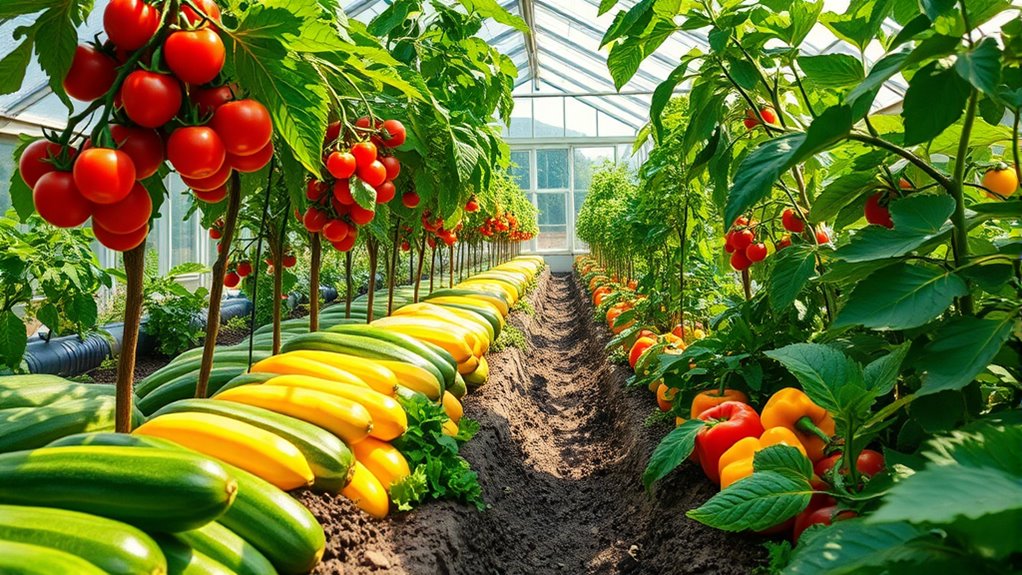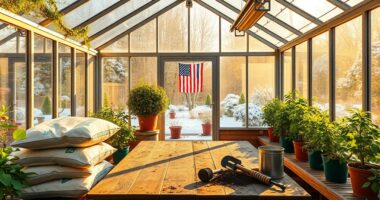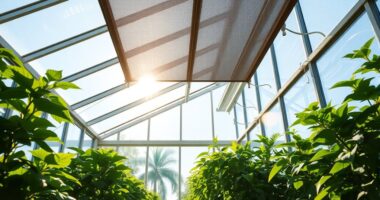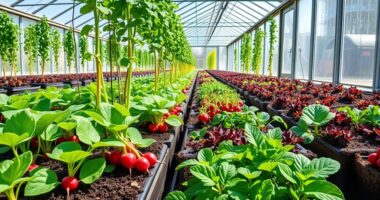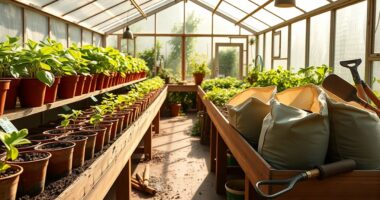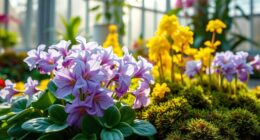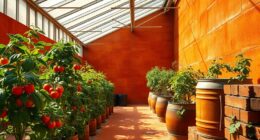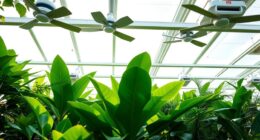If you’re looking to grow summer vegetables in your greenhouse, start with tomatoes, peppers, eggplant, beans, and squash for a bountiful harvest. Tomatoes thrive in large containers and need calcium to prevent rot. Peppers love warm temperatures and consistent watering. Eggplants prefer a nutrient-rich soil mix, while beans require well-drained soil with ample sunlight. Don’t forget to give squash plenty of space to grow. You’ll find even more tips and ideas to boost your garden success ahead.
Key Takeaways
- Tomatoes thrive in greenhouses with warm conditions; use large containers and add bone meal for calcium to prevent Blossom End-Rot.
- Peppers prefer temperatures above 18°C; choose high-yield or disease-resistant varieties for optimal growth.
- Eggplants germinate best in warm soil; maintain consistent moisture and use mulch for moisture retention.
- Beans grow well in well-drained soil with 8 to 10 hours of sunlight; bush varieties don’t need support, while pole beans require trellises.
- Summer squash needs space, warm soil, and well-drained, organic-rich soil for high yields and sweet flavor.
Tomatoes: The Perfect Summer Crop

Tomatoes are often hailed as the quintessential summer crop, and for good reason.
To successfully start tomatoes in a greenhouse, choose seeds specifically designed for greenhouse conditions. Germinate your seeds in warm environments, ideally under grow lights and on heat mats. Make sure to use large containers, at least ten gallons, to give them ample room to thrive.
Choose greenhouse-specific seeds and germinate them in warm environments for thriving tomatoes. Use large containers for optimal growth.
Prepare fresh soil and sanitize your containers to fend off diseases. Don’t forget to add a calcium source like bone meal to prevent Blossom End-Rot.
Place your plants in a sunny spot for optimal growth, and control the temperature within the ideal range. Maintaining consistent temperature control is crucial for maximizing your yield and ensuring healthy plant growth.
With proper care and attention, you’ll enjoy a bountiful harvest of delicious tomatoes all summer long.
Peppers: A Spicy Addition to Your Garden

When you think of vibrant flavors and colorful additions to your summer garden, peppers should come to mind. These versatile vegetables thrive in warm greenhouse conditions, needing temperatures above 18°C (64°F) and plenty of light.
Consider growing high-yield varieties like ‘Triple 5’ for quick production or ‘Francelia’ for large fruits. If space is limited, dwarf and micro-pepper varieties offer compact solutions without sacrificing flavor.
Regular watering and fertilization are crucial, but be careful not to overwater. Keep an eye out for pests like aphids and utilize disease-resistant options like ‘Brocanto’ to ensure healthy plants.
With their diverse colors and tastes, peppers can spice up your summer garden and satisfy your culinary cravings.
Eggplant: A Warm-Weather Favorite
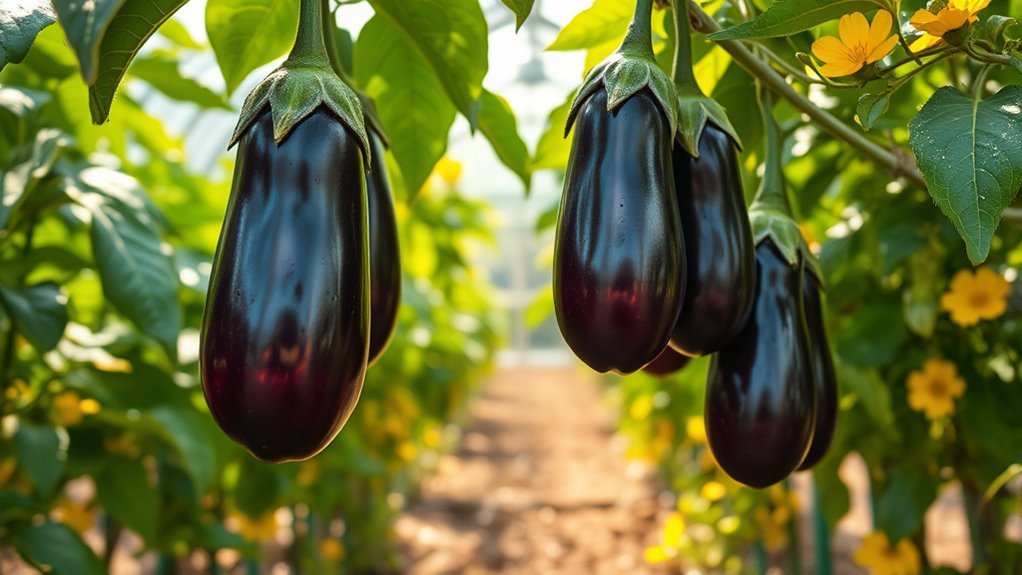
After adding the vibrant colors of peppers to your summer garden, consider planting eggplant, another warm-weather favorite that brings both beauty and flavor.
Start by sowing seeds about a quarter inch deep in a quality potting mix, 6 to 8 weeks before the last frost date. Eggplant seeds thrive in soil temperatures between 80–90°F and typically germinate within 8 to 10 days.
Once seedlings emerge, move them to full sun and keep the soil consistently moist. Use a nutrient-rich fertilizer and apply organic mulch to retain moisture.
When planting in your greenhouse, ensure daytime temperatures stay between 66–72°F. Regularly harvest eggplants when they’re glossy and about 1/2 lb for the best flavor and increased yield.
Beans: Versatile and Productive

Beans are a fantastic addition to any summer garden, offering both versatility and productivity. They thrive in temperatures between 65°F and 85°F and prefer well-drained, fertile soil with a pH of 6.0 to 7.0.
Ensure they get 8 to 10 hours of sunlight daily, and water them regularly with about 1-2 inches every fortnight. You can choose from various types, like bush beans that don’t require support or pole beans that climb with the help of trellises.
When companion planting, beans work well with corn, cucumbers, and marigolds. Harvest your beans about 10 weeks after sowing for the best flavor, and regular picking encourages more pod formation, keeping your greenhouse productive all summer long.
Squash: Ample Space for Growth

Although squash plants can be highly productive, they need ample space to thrive effectively.
With both summer and winter varieties, summer squash stands out for its sweetness and high yield. Ensure you place your squash in a sheltered, sunny spot with warm soil—ideal conditions for a well-heated greenhouse.
Summer squash, known for its sweetness and high yield, thrives in warm, sunny spots—perfect for greenhouse gardening.
These sprawling plants prefer well-drained, moisture-retentive soil enriched with organic matter and a pH between 6.0 and 7.0. To manage their growth, consider using trellises or giving them plenty of room to spread.
Typically, you can expect to harvest your squash in late August or September, depending on the variety. By providing the right space and care, you’ll enjoy a bountiful harvest of delicious squash.
Cucumbers: Fast-Growing Fruiting Vegetables

Cucumbers thrive in greenhouse environments, making them a fantastic choice for gardeners looking to maximize their yield. With a longer growing season, you can plant them earlier and harvest later.
Greenhouses protect your cucumbers from harsh weather, reducing damage and disease. Using vertical growing methods not only saves space but also improves air circulation. You can control temperature and lighting for optimal growth conditions, while beneficial insects help manage pests like aphids.
Popular varieties like English and Beit Alpha cucumbers thrive in these settings, offering high yields and disease resistance. Remember to space your plants 45 to 50 cm apart and provide support as they grow to ensure a bountiful harvest of delicious, tender cucumbers.
Basil: Aromatic Herbs for the Summer
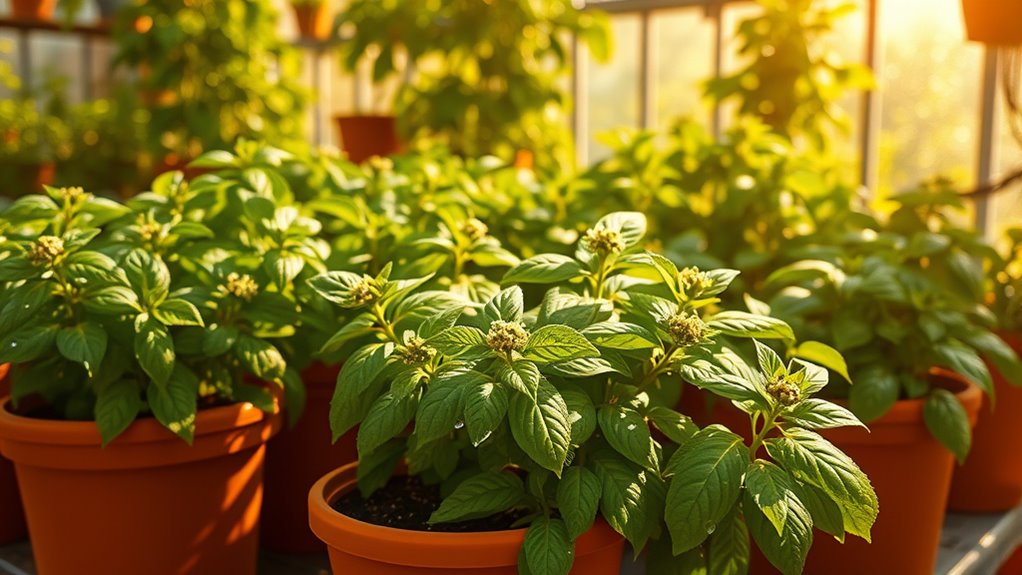
After enjoying the crisp, refreshing taste of cucumbers, it’s time to explore the aromatic world of basil.
This versatile herb comes in various varieties, like sweet and lemon basil, each offering unique flavors. Look for those with the RHS Award of Garden Merit for proven performance.
Basil thrives in warm temperatures between 21-26°C (70-80°F) and needs at least 6-8 hours of sunlight daily. Plant seeds indoors in late winter or outdoors when it’s warm enough.
Keep the soil moist and fertilize every few weeks to promote growth. Incorporating nutrient-dense ingredients like chia seeds can also enhance the nutritional value of dishes featuring basil. Harvest leaves just before the plant flowers for the best flavor.
Whether in pesto or salads, basil adds a delightful touch to your summer dishes! Additionally, incorporating educational toys into playtime can stimulate children’s creativity and problem-solving skills, much like how growing basil encourages nurturing and responsibility.
Frequently Asked Questions
How Can I Prevent Pests in My Greenhouse During Summer?
To prevent pests in your greenhouse during summer, start by maintaining cleanliness; regularly clean to eliminate breeding grounds.
Install screens on vents and windows to block pests. Quarantine new plants before introducing them, and monitor populations using sticky traps.
Control the climate by keeping optimal temperature and humidity levels. Introduce beneficial insects, practice companion planting, and use organic sprays like Neem Oil for effective pest management.
Regular ventilation also helps deter unwanted visitors.
What Is the Ideal Humidity Level for Summer Greenhouse Plants?
Think of your greenhouse as a delicate ecosystem, where balance is key.
The ideal humidity level for summer greenhouse plants hovers between 50% and 70%. This range nurtures growth while warding off diseases like botrytis.
Keep an eye on temperature changes, as they can shift humidity levels. Employ ventilation strategies and monitor with a hygrometer to maintain that sweet spot, ensuring your plants thrive and flourish throughout the warm season.
How Often Should I Fertilize Summer Vegetables in a Greenhouse?
You should fertilize your summer vegetables in a greenhouse every three to four weeks, especially if you’re using well-drained soil.
If your soil’s clay-based, aim for every four to six weeks. Make sure to choose balanced NPK fertilizers for optimal growth.
Monitor your plants closely and adjust based on their needs. Regular soil testing helps you avoid overfertilization, ensuring your plants get just the right nutrients they require.
Can I Grow Summer Vegetables in a Shaded Greenhouse?
Yes, you can grow summer vegetables in a shaded greenhouse, but it requires some adjustments.
Focus on shade-tolerant varieties like leafy greens and brassicas. You’ll need to manage light and temperature carefully since shaded areas can slow growth.
Consider using trellises to help vining crops reach sunnier spots. With the right strategies, you can still enjoy a productive harvest, even in a shaded environment.
Just keep an eye on moisture levels!
What Are the Signs of Heat Stress in Greenhouse Plants?
When your greenhouse plants start showing signs of distress, it’s like they’re whispering for relief. You might notice droopy leaves, leaf curling, or even yellowing as they struggle with heat.
Growth slows down, and you could see fewer flowers or smaller yields. Keep an eye out for wilting and water stress, as these indicate they’re feeling overwhelmed.
Monitoring temperature and humidity helps you ensure they thrive, rather than just survive.
Conclusion
So, there you have it—your greenhouse is now a summer paradise, bursting with vibrant tomatoes, zesty peppers, and lush basil. Who knew those little seeds could transform into such a colorful symphony of flavors? As you stroll through your thriving garden, just remember: while you’re nurturing these beauties, they’re secretly plotting to take over your dinner table. But hey, who wouldn’t want a veggie uprising? Embrace the chaos; after all, a little green rebellion never hurt anyone!
